Easy Escapes: Mumbai, India
Lola Borg falls in love with a vibrant city that offers a heady mix of the exotic and the familiar
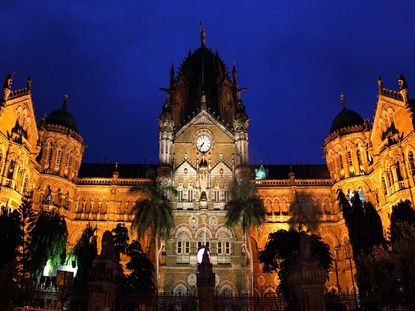
Lola Borg falls in love with a vibrant city that offers a heady mix of the exotic and the familiar
Lola Borg falls in love with a vibrant city that offers a heady mix of the exotic and the familiar
Why go? For a city break unlike any other. Huge, sprawling, noisy and flashy, Mumbai is all contrasts, a place where old and new, rich and poor bump up against each other. A cosmopolitan melting-pot that played a pivotal role as a major port of the British Empire, it's built on seven low-lying marshy islands spanned by huge motorways with miles of coastline and balmy sea breezes. The Bollywood film glitterati brings an added sheen, and the city makes an exhilarating turbo-charged first stop for trips further south or to other parts of India. And one last thing every visitor must know – the locals still call it Bombay, never Mumbai.
When? Go between October and March when the weather is hot but not melting. April and May are still good, too, but avoid June when the monsoon rains pass through. May is also holiday time for Mumbaikars so streets are emptier and hotels a bit cheaper.
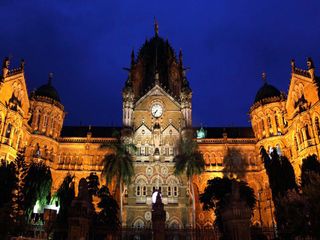
Victorian splendour: don't miss Mumbai's Chhatrapti Shivaji Terminus You really must: Do the highs and the lows – this pulsating city has both in spades. Visit South Mumbai to see its spectacular Victorian Gothic buildings that give the streets an eerily familiar look, such as the mind-blowingly ornate Victoria Terminus railway station (renamed Chhatrapti Shivaji Terminus) – look out for the carved peacocks on the outside. It's now a World Heritage site, and if you want a quick blast of the 'real' Mumbai take a ten-minute stroll into its seething interior, where Slumdog Millionaire was filmed. Nearby, by contrast, is Oval Maiden, framed by coconut trees, the calmly picturesque ground for cricket-mad locals.
The standard cliché about India is that it can overwhelm, especially for a first-time visitor, and it’s absolutely true. Mumbai especially: some 19 million people rub along here. It has one of the highest percentages of billionaires in a city but also some of India’s poorest of poor too; so ramshackle shanty houses are overlooked by the city’s largest private house built for India’s richest man, Mukesh Ambani (it cost him £174 million, is 27 stories high and houses just four residents).

Local colour: there's plenty of smiles on the streets of Mumbai © Chris Caldicott
Marie Claire Newsletter
Celebrity news, beauty, fashion advice, and fascinating features, delivered straight to your inbox!
Get your bearings with a guided city tour by nippy minibus, which can be arranged through Greaves Travel (see below). This will take in the city’s considerable heritage architecture and the main sights, such as Mani Bhavan, Gandhi’s elegant Mumbai house, now a museum (gandhi-manibhavan.org). A tour can also include grittier parts in short blasts too, such as the fascinating – though rather pongy – Mumbai fish market at Sassoon Docks, seemingly unchanged since Victorian times. If you’re not being ferried around, Mumbai’s distinctive black and yellow cabs are cheap and safe (mostly under a fiver for journeys of a few kilometres) and many places on the sightseeing or shopping agendas are clustered in the South Mumbai area. The cheapest option – walking – can be totally exhilarating – once you've had a day or two to adjust to the din and bustle, that is, and as long as you don’t mind occasional stares from the locals.
The ultimate symbol of the Raj era, the Gateway of India, like the Eiffel Tower or Buckingham Palace, is Mumbai’s tourist must-do. The humungous archway on the Arabian Sea was built to greet the royal visit of King George V in 1911. Admire it briefly, then escape the hoop-la by taking a chilled Kingfisher beer or fresh melon and lime juice (around £3) on the shady veranda overlooking the pool of the nearby Taj Mahal Palace (tajhotels.com). Mumbai's landmark hotel was the star of the recent BBC2 documentary Hotel India. The distinctive Moorish dome billowing smoke became world-famous during the terrorist attack of 2009. Today the hotel is fully restored, reeks discreet upmarket charm and has been home to every celebrity who has blown through town from the Obamas to Jemima Khan via Russell Brand.
For a culture blast, the Dr Bhau Daji Lad Museum (bdlmuseum.org) opened in 1892 as an outpost of the Victoria & Albert Museum. Recently restored, it has stunning Victorian colonial architecture, is the perfect size, and illustrates the city’s arts and crafts – much more absorbing than it might sound. At the opposite end of the cultural scale, you can take a Bollywood studio trip, but this has all the glamour and allure of a dusty parking lot and strictly for ardent fans only. Instead, end your sightseeing day on the long strip known as Marine Drive which has almost as many Art Deco buildings as Miami Beach: it’s a popular spot for a romantic stroll and to watch the sun set over the Arabian Sea.
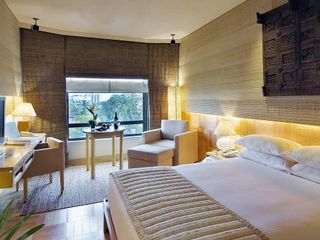
Cool India: a Deluxe Delight room at Hotel Vivanta by Taj President
Stay at: The Hotel Vivanta by Taj President (vivantabytaj.com) is a relaxed boutique hotel with 292 simple but stylish rooms – think wood mixed with traditional Indian artwork and black-and-white photos, relaxed unstuffy service and plenty of personal touches (we like the bag of essentials for the 'lady traveller' but are less keen on towels twisted into the shape of puppies on the bed). From the funkier end of the Taj hotel chain – and very affordable, especially in low season – it has a good location in leafy, upmarket South Mumbai (think Hampstead) but still close to the action with the shopping area of Colaba Causeway nearby. The hotel has a chic pool surrounded by vertiginous skyscrapers and a decent spa, the Jiva, with traditional treatments. The Indian foot massage, for around £12, is heaven for tired feet that have done too much sightseeing.
If this full-on city gets too much, or you fancy something more chilled, head for the coast and the groovy suburb of Bandra (described as the 'Shoreditch' of Mumbai). Here, slap on the seafront, is the sleek and glossy Taj Land’s End (tajhotels.com), the hotel of choice for nearby Bollywood’s movers and shakers. The 500 rooms are modern but luxurious with views of the Arabian Sea, the service friendly, the spa to die for and for those who don’t want local food, the Italian restaurant (Mumbaikars' favourite 'foreign' cuisine) is the only offshoot of San Lorenzo outside London. The hotel’s discreet meeting rooms are a preferred venue for stars to do deals – apparently – Shahrukh Khan (think Indian George Clooney with knobs on) lives down the road and is often spotted here which gives the hotel serious wattage. Plus it’s a mere five-minute hop by tuk-tuk to hit Bandra’s über-cool bars and nightlife.
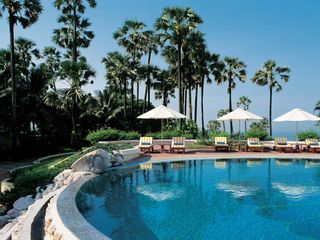
Bombay sapphire: after a hard day's sightseeing hit the pool at the Taj Land’s End hotel
Dine at: After an exhausting day out in the heat and hectic streets, hotel dining makes sense. You’re in luck at the Taj Vivanta. Start the evening in the hotel’s dark and atmospheric cocktail bar, Wink, with a signature Winktini cocktail (with vodka and lychees). If the mixologist's in the mood he may even juggle with some flaming bottles of spirit (and not a Health & Safety consideration in sight). From here, stagger to the hotel restaurant, The Konkan Café, which offers coastal cuisine from further south (the Konkan region includes Goa and Kerala) and features delicately-flavoured recipes with an emphasis on fresh seafood and liberal use of coconut. For those who have only ever had Bombay Duck at their local Indian, the fresh version is a revelation. Dinner will set you back in the region of £30 for two. Mumbaikars love eating out and they are catching onto the idea of pop-ups. For suggestions, try timeoutmumbai.net and zomato.com. Once back home, Bombay Lunchbox (£9.99, Frances Lincoln) by Carolyn and Chris Caldicott has delicious recipes for sweet and savoury vegetarian snacks inspired by the country's Anglo-Indian cuisine.
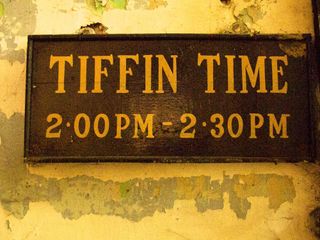
Spice up your life: tiffin (lunch) is a mainstay of the Mumbai lifestyle © Chris Caldicott
Bring home: Could you really get back on the plane without a new pashmina? This is India after all. Checks and stripes are the savvy buy for a winter scarf so light and warm it will ruin you for any other. Steer clear of being fleeced by hagglers on Colaba Causeway, Mumbai’s main shopping drag. Instead stick to a department store such as The Bombay Store (thebombaystore.com) which sells funky household goods too, as does Good Earth (several locations, goodearth.in). The museum shop at the Prince of Wales Museum (renamed Chhatrapati Shivaji Maharaj Vastu Sangrahalaya, csmvs.in) is a great one-stop shop with crafts from all over India and government-run so no haggling: pick up presents and pashminas at good prices after visiting the museum, which contains Indian art, sculpture and even stuffed animals and birds from all over the subcontinent. Pashminas start at around £40 and other trinkets, such as carved elephants, from a few pounds. For clothes, head for FabIndia (several locations, fabindia.com) which sells hand-printed Indian womenswear – both modern and traditional – at insanely reasonable prices; a printed cotton blouse, for example, retails at less than a tenner.
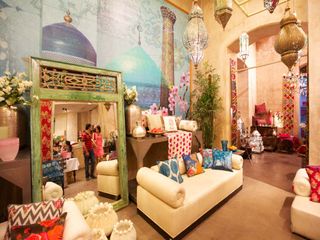
Home comforts: get shopping at Good Earth © Chris Caldicott
Book now: Greaves Travel (greavesindia.co.uk) offers tailor-made tours to India. A four-night package to Mumbai costs from £1,350 per person based on two sharing, including return flight from London Gatwick or Heathrow with Virgin Atlantic, two nights at Hotel Vivanta by Taj President and two at Taj Land’s End, plus breakfast, transfers, sightseeing tours and an afternoon with a personal shopper. For a treat, add on a VIP package with Virgin Atlantic’s Guest List which includes a chauffeur-driven car to the airport and fast track check in, plus Clubhouse access (from £240 per person one-way, virginatlantic.com). For more flight options, see skyscanner.net. A pre-paid taxi from the airport (use the booking counter in the Arrivals Hall) costs around £10 and takes 40 minutes.
Visas: Getting a visa is mandatory and can be tiresomely bureaucratic (many blame the Indian love of red tape on the British) so apply well in advance (in.vfsglobal.co.uk). Visitors must apply both online and by written form. Be warned, it’s a labyrinthine process.
Safety: Mumbai is generally safe for women – and certainly feels that way but since the recent well-publicised rape cases the UK Government advises caution when travelling and to avoid public transport late at night. Dress for women is pretty conservative compared to the UK, so cover up in loose, light clothing and save shorts for the beach. The Foreign & Commonwealth Office (gov.uk/foreign-travel-advice/india) issues guidelines for women travellers. Take care with street food and keep hands clean - an antibacterial hand gel is useful.
Info: Get in the mood by watching Slumdog Millionaire or read the autobiography Shantaram by Gregory David Roberts (£10.99, Abacus). Wallpaper* City Guide Mumbai (£6.95, Phaidon) is an excellent concise guide for hipsters, or Time Out Mumbai & Goa (£12.99, Time Out) gives a thorough overview. For what's on see timeoutmumbai.net.
The leading destination for fashion, beauty, shopping and finger-on-the-pulse views on the latest issues. Marie Claire's travel content helps you delight in discovering new destinations around the globe, offering a unique – and sometimes unchartered – travel experience. From new hotel openings to the destinations tipped to take over our travel calendars, this iconic name has it covered.
-
 We're fitness experts who've spent 100's of hours testing fit kit - these are the lululemon products we rave about to family and friend
We're fitness experts who've spent 100's of hours testing fit kit - these are the lululemon products we rave about to family and friendKeen to invest in kit that'll last the long run?
By Chloe Gray
-
 Taylor Swift has broken her silence on the meaning of new track ‘Clara Bow’
Taylor Swift has broken her silence on the meaning of new track ‘Clara Bow’By Jenny Proudfoot
-
 George, Charlotte and Louis are learning "new home rules" to help Princess Kate's recovery
George, Charlotte and Louis are learning "new home rules" to help Princess Kate's recoveryBy Jenny Proudfoot